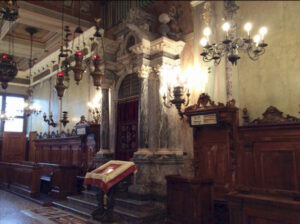The Italian synagogue, cornerstone of identity
 Three were the synagogues once in operation in Padua. In addition to the German one, once damaged by the Fascists and seat of the Jewish Padua Museum today, also the Sephardi one, converted into a private home, and the Italian one, still in use today, animated the praying and worshiping life. The latter, as documented by the Jewish Cultural Heritage Foundation in Italy, has sixteenth-century origins and was perhaps founded to replace “the previous Italian rite oratory located in Piazza delle Legne”.
Three were the synagogues once in operation in Padua. In addition to the German one, once damaged by the Fascists and seat of the Jewish Padua Museum today, also the Sephardi one, converted into a private home, and the Italian one, still in use today, animated the praying and worshiping life. The latter, as documented by the Jewish Cultural Heritage Foundation in Italy, has sixteenth-century origins and was perhaps founded to replace “the previous Italian rite oratory located in Piazza delle Legne”.
The current site was identified at the beginning of the seventeenth century, with subsequent completion of the interiors and further renovation during the nineteenth century. The synagogue hall is characterised by an “oblong rectangular plan organized according to the traditional bifocal model, with the aron and the tevah leaning against the centre of opposite walls. The larger ones in this case”.
The Aron, the cabinet that houses the Torah scrolls, shows curious characteristics, with features common to the contemporary altars of some Venetian churches. Accordingly, it is closed “by carved and gilded wooden doors and framed by an aedicule structure with grey veined marble columns and a broken semi-circular tympanum”. On the opposite side, is an elaborate canopied tevah. According to a tradition, it was entirely built out of the wood of a plane tree of the Botanical Garden struck down by a lightning. Closed to worshippers in 1892, when the community leadership chose to bring together rituals and traditions in a single space, the one on which the barbaric Black Shirts would rage, the Italian synagogue returned to being used in the immediate post-war.
Above, the Aron, the cabinet that houses the Torah scrolls, in the synagogue of Padua.
Translated by Gianluca Pace, student at the Advanced School for Interpreters and Translators of the University of Trieste, intern at the newspaper office of the Union of the Italian Jewish Communities.
Revised by Oyebuchi Lucia Leonard, student at the University of Trieste, intern at the newspaper office of the Union of the Italian Jewish Communities.
